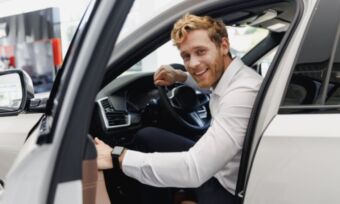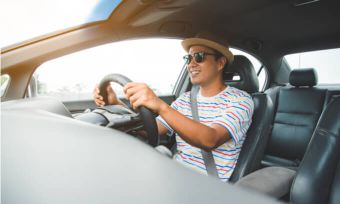KEY POINTS
- If you hit a kangaroo while driving, first check the safety of yourself, your passengers, and the animal.
- Contacting a wildlife rescue service, followed by your insurer, can help make sure the kangaroo and your vehicle are well looked after..
- Making a car insurance claim could mean losing your no-claim bonus, which could lead to higher premiums in the future.
What to do if you hit a kangaroo
A report into animal collisions released by AAMI shows kangaroos are the most common animal to be hit by cars nationally. Animal collisions have also increased by 22% year on year, attributed partly to drivers ignoring animal related road signs. So, what steps should you take if you hit a kangaroo while driving, and what can you do to help prevent future accidents?
According to Lisa Yeomans, a carer at New South Wales Wildlife Information, Rescue and Education Service Inc (WIRES), the first thing to do is to pull over, if it’s safe to do so, and ensure everyone in the car is okay. It’s also important to check on the animal, as your actions immediately following an accident could affect the survival of the kangaroo or its young.
WIRES suggests following these steps if you accidentally hit a kangaroo with your car:
- Stop and check the animal, where safe: pull over using your hazard lights and don’t stop on a corner. Wear hi-vis or bright clothing, if you have any. If it’s not safe to stop, notify the local wildlife rescue organisation closest to the animal’s location.
- Call a wildlife rescue organisation: make a call to a local wildlife rescue centre or veterinary clinic (such as the RSPCA or WIRES) immediately for advice.
- Check the pouch: look for obvious lumps and movement in the pouch area and then, if the adult kangaroo is unresponsive, look inside the pouch itself. Also check the surrounding areas for joeys that may have been thrown from the mother’s pouch on impact.
- Remove the joey: if it’s not attached to a teat, keep it warm and in a quiet place. Don’t offer the joey any food or liquids unless advised to by a wildlife group or vet, and handle it as little as possible. If you find a joey attached to a teat, don’t attempt to remove it unless you are advised how to do so by WIRES or another wildlife organisation.
- Carefully remove the kangaroo’s body from the road if you’re sure it’s deceased and you can do this safely, so it won’t be a hazard to other motorists or attract animals that feed on carcasses. However, large mammals like kangaroos can be very heavy, so consider your own risks before moving them.
“If you hit an adult kangaroo and it’s still alive, don’t go too close as they can be dangerous when they feel threatened, or could try to move, which is not safe for them”, Ms Yeomans says. “Check if there are joeys nearby as parent kangaroos can be very protective and this could lead to further stress for the animal. If you can, try to place a blanket over its head to help keep it calm until help arrives.”
“Mark the location or identify a landmark, and take a photo of the mum,” she continued. “The more information we have, the better the chances we can identify the particular species of kangaroo and rehabilitate it successfully. We will also send someone out to check on the adult kangaroo, in case they were just knocked unconscious and need assistance.”
It’s a good idea to pause and gather yourself before you begin driving again, as the shock or adrenaline could affect your focus and judgement on the road. Miss Yeomans advises that even if you think a kangaroo may have been at the side of the road for a while, it’s still important to check it and contact your local wildlife rescue organisation, as joeys can potentially survive in a pouch for several days. This is also true if the animal hopped away, as it may be injured and need assistance.
Who to call if you hit a kangaroo
To find your nearest wildlife rescue organisation, take a look at the following list:
- Australian Capital Territory: ACT Wildlife – 13 22 81
- New South Wales: WIRES – 1300 094 737
- Northern Territory: Wildcare Inc – 8988 6121 or 0408 885 341
- Queensland: Wildlife Rescue Queensland – 0478 901 801
- South Australia: Fauna Rescue – (08) 8289 0896
- Tasmania: Bonorong Wildlife Rescue – 0447 264 625
- Victoria: Wildlife Victoria – (03) 8400 7300
- Western Australia: FAWNA – 0438 526 660
Alternatively, call the closest police station.
Will car insurance cover damage caused by hitting a kangaroo?
Depending on your insurer, and presuming you were driving legally, you may be covered for the costs of repairing your car if you hit a kangaroo while you have a comprehensive car insurance policy. This may also include if you were in an accident while trying to avoid hitting an animal (though the general recommendation is to avoid swerving, as this can put you in more danger). According to a spokesperson from the Insurance Council of Australia (ICA), insurers will generally treat damage to a vehicle from colliding with an animal the same way as damage resulting from evasive action to avoid an animal when assessing a comprehensive car insurance claim.
Compare Car Insurance with roadside assistance
Keep in mind that making a claim on your car insurance could affect any no-claims bonus you may have, and your premiums could increase as a result. You will typically also be required to pay an excess, which is an agreed amount you pay to the insurer whenever you make a claim.
If you hit a kangaroo or have a car accident without car insurance, you may need to pay for repairs to your car out of your own pocket. Any third parties injured in the accident should be covered by your Compulsory Third Party (CTP) insurance. If you have a different type of insurance from comprehensive cover, your policy may only cover the cost of repairing damage to other cars and third party property damage.
How to make a car insurance claim if you hit a kangaroo
Once you’ve checked the welfare of people around you and the animal involved (if it’s safe to do so), the ICA recommends taking the following steps:
- If you need a tow truck, there has been significant damage or anyone has been injured, keep in mind that in some states you’re required to notify the police.
- Write down the following details about any other party or parties involved:
- Name
- Phone number
- Vehicle registration number
- Address
- Licence number
- Car insurance details
- Statement of what happened
- Name
- Gather the names and phone numbers of any witnesses to the accident, in case you need to contact them later.
- If it’s safe to do so, take photos of the accident scene and the damage caused to your vehicle and any others (if other vehicles are involved).
- Contact your insurer to discuss your next steps, including moving your damaged vehicle to a repairer and, if your policy allows, using a hire car while yours is being repaired.
What happens to kangaroos taken into care?
Miss Yeomans said she could have up to nine animals in her care at any one time, though four is a more comfortable number, considering young joeys require five bottles of milk a day, plus being toileted.
The younger ‘pinkies’ rely on a regulated humid, low-oxygen environment and regular feeds using a specific formulation that closely mimics the nutrients they would receive from their mother. They also eat grass and, according to Miss Yeomans, even dirt to help develop their immune systems.
Once a kangaroo is healthy and at an age where it can fend for itself, the wildlife rescue organisation will identify the best location to release it – usually within 100km of the accident site and near where there is a known ‘mob’ of the same type of roo. “If kangaroos are taken in by an authorised carer quickly and looked after properly, the chance of a successful release is quite high,” Miss Yeomans said.
“The most crucial part is making sure they get to a carer who understands the needs of the kangaroo as soon as possible – each hour can decrease their survival rate. Even for those who don’t make it, it’s rewarding to know we gave them an environment where they were loved and cared for, and they were as peaceful and comfortable as possible. It drives me to do my best to help the next rescue achieve a successful outcome, knowing I can make a difference and give these little guys the best chance possible.”
Why are animal collisions increasing?
Miss Yeomans said the generally dry weather and an increase in urban development over the past few years have seen an increase in the number of callouts she receives to rescue injured kangaroos from the side of the road.
An AAMI spokesperson agreed, saying the insurer is expecting an increase in kangaroo related collisions, as they seek out available food closer to the road. “Drivers need to be extra vigilant, particularly at dawn and dusk, when kangaroos are most active,” the spokesperson said. “Wild animals can be unpredictable, especially when startled by cars, so we encourage drivers to expect the unexpected.”
For more information or to donate, visit the WIRES website.
- Save 15%^ on your first year’s premium when you purchase a new Car Insurance policy online.
- 24/7 Phone & Online Claims.
- Budget Direct - Insurance Solved.
- Insurance that's a bit more you-shaped.
- Canstar’s 2025 Most Satisfied Customer Car Insurance – NSW, VIC, SA
- Lodge a Claim 24/7 with our Advisors
- Collect 10,000 Flybuys Points with a new Comprehensive Car Insurance Policy for Flybuys members. Ends 30/1/26. T&Cs, Excl Apply.
- Earn up to 40,000 Qantas Points with every car insurance policy. Ends 28 Jan. Plus save 15% on your 1st year’s premium when you purchase online. T&Cs apply.
- Boxing Day Sale: Complimentary Roadside Assistance for 12 months. Choose your own repairer. Up to 10% off your first year's premiums. $10 monthly kogan.com credit
Cover image source: Vibe Images/Shutterstock.com








